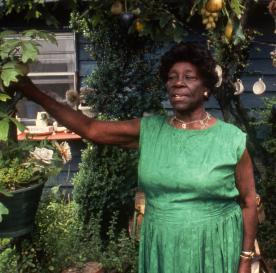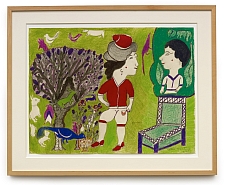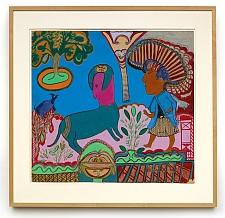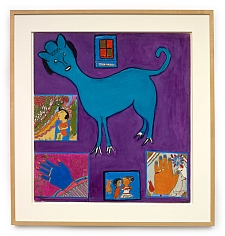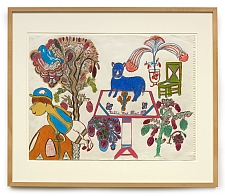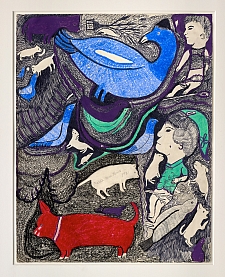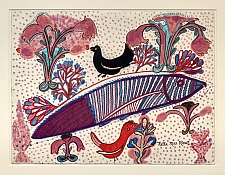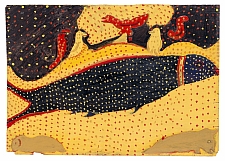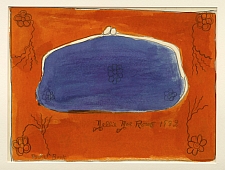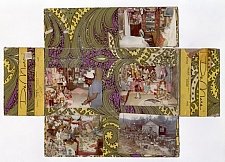Nellie Mae Rowe was forty-eight years old when Henry, her second husband, died.
As a young girl, she had picked cotton and worked in the fields with her family in Fayette County, Georgia. Her father, Sam Williams, a blacksmith and farmer, occasionally hired the children out by the day to work in the neighbors’ fields. It was a proud and self-sustaining family.
Young Rowe was not satisfied with her life as a field hand. The work was painful, poorly compensated, and undignified. So at sixteen, she married a young man a few years older than herself. In 1930 they moved to Vinnings, on the outskirts of Atlanta. Marriage perhaps seemed preferable to fieldwork but did not turn out to be. Her life on the farm was probably better than life in the kitchen or the bedroom.
Her husband, Ben Wheat, died in 1936. Later that year she married again, a widower much older than she, a man who was a well-respected member of the Vinnings community. When Henry Rowe died in 1948, Nellie Mae Rowe found herself, for the first time in her life, answerable to no one. She had always been a field hand, a wife, or a domestic servant. Now she had the freedom to imagine herself in roles different from those defined for her by others.
Seventy-five cents a day. All-day long for seventy-five cents. I did like to hear at dinnertime when the bell ring. I know we was going to have plenty to eat. Lord have mercy. I wish I could eat like that now. We worked and we ate aplenty too. Foods don’t eat now like it did when I was a child. You cook anything in an iron pot, it better than this here aluminum pot. We eat, and when we go into the fields, the girls and boys . . . we worked. We done good work, and most everybody wanted us to work with them. Folks pick out who they want to work for them, who’s smart. I was about sixteen when I run off and got married. I should have stayed home. I’d a been better off. Then I come up here and married again, Henry Rowe. I lived a good little life, and after he died, I said, “I ain’t fooling around no more.”
“Ain’t fooling around no more” meant establishing an identity for Nellie Mae Rowe. She recognized the carefree quality of childhood, the freedom to create, improvise, and play, as a necessary ingredient for her renewal. “I’m going back to my childhood."
She remembered happier days when she would “play in the playhouse, find something, pretty rock or pretty flower or old broke plate or something, get it and make a playhouse, in the pines, rig the straw up. Look like time you get start to play and that’s when they call you into the house to do something. I enjoy playing. I ain’t trying to keep house now, I’m just a-playing house. I just got my playhouse like I’m come back a baby again.” The first step was to announce herself. She began to turn the front yard of her two-room cottage into an elaborately decorated space that she later referred to as her “playhouse.” In an enclosed area she gradually added dozens of objects—from stuffed animals to household bric-a-brac—suspended from trees and clotheslines and nailed to the façade of the house. She made life-size dolls and placed them around her yard (they often got stolen): she made chewing-gum sculptures and set them on the fence surrounding her property (they often got stolen, too); and she shaped the hedges to look like animals.
Her yard was not unusual relative to African American yard shows throughout the South. But it faced Paces Ferry Road, a major Atlanta residential route, and was only a few minutes away from the city’s most exclusive white neighborhoods. The message of this middle-aged African American widow seemed eminently clear: I am Nellie Mae Rowe. This is my place and I will make of it what I please. Be aware of me.
She decided to resume drawing, her favorite childhood pastime:
I ain’t gone to school to learn no work like that. I guessed at it when I was a little gal, just lay down on the floor and draw. See, we had to go to fields, pick cotton and all like that. I didn’t have a chance like I have now, and every chance I got, I got my pencil, I got on the floor until they say, “Nellie, let’s go.” And then I’d go. . . . I’d lay my pencil down at night, take a bath, get ready for bed. I just had to go get my pencil and draw something. That was in me and it’s still in me. They didn’t ever much bother me. They’d be doing other things and I’m doing what I’m going to do. . . . That was just in my mind. I don’t be knowing what it is myself. Folks draw, they know what they’re drawing. But they say that I, my soul, look back in wonder. So that’s the way it is. That’s a song, kind of like hymn: My soul looked back in wonder, I ride over, I ride over.
Unlike many African American artists, who found little support at home for their early artistic efforts, Rowe was always encouraged by her parents. Her father was a blacksmith and basket maker and her mother made quilts and clothing, so both appreciated their daughter’s creativity. But opposition and obstruction came from other directions, and until the last years of her life, when her work was becoming respected and appreciated, Rowe was forced to defend her art and her living space against various unexpected adversaries. The first of them came when she was a child, living “nowhere; out in the country.” She made a paste of flour and water to attach her drawings to the bedroom wall:
I’d make up a dough, you know, and stick it up inside the house. The rats would be there, so way in the night the rats would be gnawing on that paper on account of that flour behind it. And I’d hear them tearing through the night and I’d get me a hat pin. You could see the rats working under there. Just like that I’d get the hat pin. . . . Oh! I did it! And they just stay in there until next morning. I did that many times. I was mean then. I was a mean little old short thing, an Indian, you know, with my britches up. I give it to them. I say, “You won’t gnaw on there no more.” I took that pin and jab it through them and they stay there. Next morning I pull it out and them fall. I knew they was dead then.
Seventy years later, as she faced death from cancer, she still worried about her youthful cruelty to the rats. She assumed that the Lord had understood: “It’s all forgiven ‘cause it was in my childhood.”
When she decided later in life to “decorate the outdoors” in front of her house, she encountered an unexpected and more frightening type of adversary, one whose opposition was based on ignorance rather than hunger:
I started doing it way ago, right after my husband died. He died in ‘48 and then people just started to bring in this, bring the dolls, and bringing me things. I take nothing, you know, take nothing and make something out of it. See, a lot of folks, they crawl, run in here, inside, knock my fence down, tear up lot of that. Everyone used to be so mean to me around here. They started off being very, very mean to me. They throw rocks and knock my window out, rocks all up against the house, firecrackers and everything and old rotten eggs all over my house. And I kept on tolerating and talking with the Master until everything was all right. I prayed and asked God and he moved it. See, I kept my things hanging outdoors in the trees. These old weavings, I’d make the eyes on them, make the big popeyes. They thought I was a hoodoo or something like that. I put up wig heads. I put the wig on them and sometimes have a shawl hanging on it. From here look like a person sit up in the tree.
The evolution of Rowe’s drawing proceeded slowly. Most of her work in the sixties and seventies consisted of little more than a single image, probably a symbolic one—a hand, a fish, an animal, a human face or figure—unembellished. Her vision, ambition, skill, and the complexity of her work expanded considerably during the last four years of her life. Judith Alexander, her close friend and art dealer during that time, arranged many exhibitions of Rowe’s work, engendering a positive effect on Rowe’s confidence and enthusiasm. An appreciative audience was forming, and though the numerous visitors that descended upon her did not necessarily detect her work’s messages, it was clear that they loved the messenger and the messenger’s work. But the most significant single cause of her dramatic artistic acceleration was probably the realization that death was near (she was diagnosed with terminal cancer in 1981 and died in 1982). She wanted to ensure that by the end of her life her talents were fully developed and utilized, perhaps, as she often said, to prove her worthiness to Jesus, but, as likely, to prove her worthiness simply to herself.
Rowe liked to talk about herself as though she were experiencing a second childhood: drawing was the center of that childhood. Her stylistic naiveté and seemingly simple subject matter would tend to enforce that contention. But something else was going on.
Each of her drawings has a specific purpose, a specific action. Most drawings are composed of an array of elements: trees, human figures (often a form of self-portrait), animals, birds, flowers, and less often, houses, roads, pieces of furniture. The relationships among the elements are well-thought-out and form a disguised narrative that is metaphorical and often satirical.
The late drawings are all autobiographical. Many deal with aspects of Rowe’s life that she would like to have seen improved. She conceals a lifetime of suppressed resentment beneath a “peaceable kingdom” innocence and a sense of humor exemplified by a use of ironic symbols and private visual jokes/anecdotes.
Something That Ain’t Been Born Yet is a humorous look at men. A plaid equine animal with a single horn and long tongue is presented against a ground that simulates the pattern of the artist’s chenille bedspreads. The ideal man that Nellie Mae Rowe never met is the “something that ain’t been born yet.”
Fish is about sex and reproduction, perhaps an observation about Rowe’s own inability to bear children. Female reproductive organs are transformed into trees. A bird plucks a red, cherry-like fruit, while another pecks at an anthropomorphic bush.
Rowe registers a humorous complaint about excessive male sexual demands in Woman Scolding Her Companion. The woman, Rowe herself, assumes a combative posture and turns away a peculiar creature that resembles a penis with a dog’s body. Other images adorn the drawing and enforce the central topic: between the two antagonists is a phallic staff with a smiling male face (virtually identical to dance wands used by the Yoruba of Nigeria in rituals honoring Shango the Thundergod); a fruit bowl—or fountain or birdbath—surmounted by an erupting green apple. On the side of the bowl, there appears to be a slice of watermelon, an obscure but specific sexual innuendo, and several small imaginary animals, all sexually referenced.
One of the oldest types of African American ritual objects associated with death/funerary rites is the decorated vessel called the “memory jug.” Such objects were usually ceramic, occasionally concrete, and were embedded with everything from broken glass and rocks to personal mementos belonging to or relating to the deceased. Another related traditional object, the ceramic “face jug,” can, like the memory jug, be traced back at least to the nineteenth century in North America. Both traditions have antecedents among African, European, and native cultures of the Americas. Nellie Mae Rowe, feeling herself to be in declining health in 1980, modeled a Janus-faced doll of gum she had chewed, decorating it with personal articles of adornment, including rhinestones, pearls, and ribbons (Two-faced Head). Embedded in the top of the head is a bottle cap: Rowe intends this piece to be a metaphorical vessel for her soul, similar to the pocketbook drawing done at the end of her life. In the tradition of grave markers, encompassing the last objects used by the interred, and charms incorporating the subject’s hair, nails, saliva, and even dirt from footprints. Rowe uses her own chewing gum to further personalize and empower the object.
A well-publicized tragedy prompted Rowe’s Atlanta’s Missing Children in early 1981. The drawing consists of five separate “charms,” each with a different significance, collectively intended to protect the African American children who were systematically being abducted and murdered. The charms surround a blue animal, similar to many of the benevolent blue dogs and pigs that populate Rowe’s works. But this animal has cloven hooves and an entirely suspect countenance. It is a malevolent creature. Rowe seems to be warning the children that the killer may well look familiar and friendly. Two of the charms are protective “mojo” hands, probably the artist’s. (She wrote in 1981, “I leave my hand on the wall. I’ll be gone to rest, but they can look back and say “That is Nellie Mae’s hand.’”) A small girl in red, probably the artist as a child, sits in a blue chair in another of the charms. All three are in blue “frames”: further protection. In a small charm framed ominously in black at the bottom of the picture, an unhappy male child appears to be scolded by an older female. Perhaps Rowe senses something about the killer’s childhood that contributed to his pathology.
Animals are prominent in most of Rowe’s drawings. She finds many ways to employ them in her narratives. In some works animals are used, a la Orwell’s Animal Farm, to act out and satirize the flaws and foibles Rowe recognizes in the human world. Perhaps some animals are Rowe self-portraits; Molly the black mule, for example, forced to work against her will, or the many little dogs who confront, oppose or ignore their masters. But though she loved to draw animals, she refused to own one. A woman so opposed to having her own life controlled by others could not bring herself to determine the fate of another living thing.
I seen a whole lot if I don’t see nothing else. I seen more than I thought I’d ever see. When I was coming up in the fields picking cotton, anybody told me I’d a-see what I’ve seen now I wouldn’t have believed it. I just always thought I’d always have to work in the fields a lot. We had to work too hard when coming up all in our younger days. Work in the fields so hard, and wasn’t getting nothing, but we was forced then. All-day long in the hot sun, sunup to sundown. I don’t like to look at it. That was the older people back then, and these here now can’t help what was done back then in slavery time. My daddy told me. He was in slavery time. He said that when he was a boy in slavery time, he said they poured in food just like you feeding a hog, pour it in a trough. They’d have a long trough, made you sit there. You had to get down and lap just like hogs. That’s what he said. I don’t like to look at that. I won’t look at “Roots” ‘cause that’s back in it. It make you feel so bad to see how they whipping that one, and whipping one that’s tired, and they’s whipping and the blood come out, and I just don’t ever look at what you call “the roots.”
But that’s the reason I said that about the other generation. That was back in slavery time, that ain’t now. That don’t make me have nothing against nobody now. But I don’t want to look at it. God knows in heaven that I’ve loved people, don’t make no difference what color they are. That son says, “I don’t hate nobody. I love everybody.” I try to. But I just don’t like to look at that. I think to myself, “If I’d a-been coming on then it’d been my skin.” Wasn’t that pitiful? Sell them. Sell them. You know, a good stock. I had my daddy. He’s telling me. He said, like getting a good stock of hogs or a good stock of cows. They put them together. They’d pick out the good stock, just like if you’s big and fat and healthy they’d see a man over there was healthy and they’d put them together so they’d have healthy childrens. Just like you do stock marriage. That’s what they do then. I had my daddy tell me that many times. They’d make a nice couple, you know, to raise children that’d be good workers. See them plowing in the field barefooted and some old swap hat on, and they looked back and the boss maybe looking at them. Oh Lordy, Lord have mercy. That’s mean. Seem pitiful, seem pitiful.
In 1981 Rowe learned that cancer was present in her body. From the point of that diagnosis, it appears that each of her drawings dealt with the subject of death. Just as she had taken control of her life, and used her art to define and explain it, she prepared to take control of her death. She devised an elaborate vision of the next world, and she modified her complex system of symbols to apply to her new challenge. Her statements, and her drawings, indicate that she had no fear of dying, but rather regarded it as a passage to an improved existence.
In her final year, many of her drawings contained inscriptions, such as
I Will See You Later Bird
Lost Lost Dog
Sleepy Girl
I Have a Ride at Last
I Will Be Back When the Weather Gets Cool
Going Home
One, with dismembered body parts, tells us, “I will see you later when I get myself back together.”
A remarkable drawing done in 1981 called Picking Cotton could have been called “What I don’t like about my life as I look back on it.” The artist is seen bending over near a grassy field (not really a cotton field, the cotton field suggested in the title simply symbolizing the most degrading form of manual labor). She is wearing a party dress, an insistence that fieldwork is not her lot. On her back is what she referred to as a cotton sack, but it appears as a woman in a compromising sexual position. The figure of the artist is imposed upon by a black mule, the mule a symbol of forced labor, the color black, death. Looking directly into the posterior of the cotton-sack female is a seated white woman, probably representing Rowe’s employers during her many years as a domestic servant. The woman is sternly scrutinizing her. Beneath the chair is a red rodent, an image used by Rowe to signal an unpleasant situation, and a sinister-looking fish, a phallic connotation in Rowe’s work. In the lower-left corner sits a grinning green man, an overseer or husband, perhaps. He sits and watches her as she works, illustrating a complaint Rowe had expressed about her husbands. One of Rowe’s most prominent symbols appears twice here: a brightly colored bird with a curved pointed beak, plucking fruit from a tree. This bird may be a specific reference to a man taking advantage of a young woman. It may also serve as many of Rowe’s animal metaphors do, to symbolize a characteristic of society in general, in this case, its predatory, scavenging instinct. Or it may represent sickness, pecking away at Rowe’s life.
In Nellie’s House at Night (1981) she reveals her illness: a frightening white doglike animal sitting in front of a tombstone beside her house. The house is empty but is lighted inside. There is a slight presence of life—small flowering plants bloom in the window; floral designs flank double doors (passageways into and out of life). The roof is blue, a color used throughout the South in African American homes to ward off evil spirits. Rowe depicts herself as a brown pig. Here it seems to float upward, ascending to the green pastures, eyeing the comfort of heaven’s abundant fruit trees and protective branches.
Rocking Chair (1981) focuses on Rowe’s most striking symbol of death, the empty chair. Apparently, this piece was created shortly after Rowe was told she had cancer and is probably her first use of the empty chair as a metaphor for death. Although the interior scene is lively and animated, there are repeated references to death. Rowe, who had quilted earlier in her life, constructs the drawing like a traditional African American strip quilt, each panel containing its own set of design elements, symbolic objects, and stylistic conventions, all combining into a unified and balanced composition. There are many identifiable components, all of which imply impending death and all of which can be found in other Rowe works of 1981. Among the more obvious are an angel, dying plants, butterflies, and a black dog. There are others more complicated, private, and esoteric, among which are a simple flowerlike fan blade, (the life cycle, presumably); a small animal plucking the fruit from a vine (Rowe uses this image to denote various indignities to woman, not the least of which is the perforation of her body); a checkerboard (life as a game of chance?), next to which is a cat playing with a target-like ball, a variation, perhaps, of the “life is a game” theme; and a root, a forked stick, growing out of a small foot, with one branch culminating in a doll (Rowe was a prolific dollmaker) and the other ending at a dancing figure representing Rowe as a little girl. When Rowe contemplates the end of her life, she frequently employs imagery depicting its beginnings.
In Empty Chair (1981), the adult Nellie Mae Rowe, dressed in red, turns away from a celebratory tree of life surrounded by birds and animals. She looks toward death, summed up as her past and future: above the empty chair is the specter of young Nellie Mae in the green pasture, flanked by two nose-diving birds. Below the tree of life, a bird plucks the berries from a potted plant or fruit basket.
On July 4, 1981, Rowe’s eighty-first birthday, she executed a drawing indicating her belief that she was celebrating her final birthday (Nellie's Birthday). An empty chair, dying plants, a tree of life outlined in black, a tombstone inscribed with the day’s date, a blue dog—an ancestral symbol among the Kongo of Zaire, perhaps the same in Rowe’s work. A female figure, representing Rowe as a young woman, leans toward the tombstone.
Woman Flying a Butterfly Kite (1981) is Nellie Mae Rowe walking uphill on a road flying a kite in the shape of a butterfly. She is barefoot, but as the spiritual has promised her, she will get her shoes in heaven. She leaves the empty chair behind, walks past the water, heads toward the green pastures and the heavily fruited trees (phallic, with testicles—shall heaven provide Rowe with a compatible mate, and children, things life denied her?).
In her later years, Rowe lived equidistant from two interstate highways that quite literally identified and delimited her world: I-75, which bisects the city of Atlanta, and I-285, which Atlantans commonly refer to as the Perimeter. The road has an ongoing presence in Rowe’s work. “Going up the road” or “crossing the road” became synonymous to her with dying. An earlier Rowe work, Pig on Expressway (1980), introduces the theme and predicts her own death.
In 1982, close to death, Rowe created Pocketbook. The pocketbook is surrounded by dying flowers in the four corners of the drawing. Rowe’s closest personal possession, her purse, becomes her traveling bag for the longest journey of her life. It is blue, inscribed with three living flowers, and floats on a red ground like a spaceship transporting her soul to the heaven she had been waiting to visit.
One of her last pieces, entitled At the Riverside (1982), was drawn with a marking pen that was running out of ink. Rowe seems to be musing on the idea that her life, the picture, and the ink will all run out at the same moment.
The Lord got me here for something. I don’t know, a lot of people say I preach. You know, a lot of people, women, they preachers, and a lot of men preaching. Now God didn’t probably call on them to preach, he calls some of them to teach. . . . But they tell you the teachers gone a-preaching.
I don’t know what he put me here for, but he got me here for something ‘cause I don’t draw like nobody. You speak one way, but I come on and say it different. You can draw a mule, dog, cat, or a human person, I’m going to draw it different. ‘Cause you always see things different. Each person’s different. I can sit here right now and look down there on the floor; I can see something, it look like it something I could draw. I was right down to the hospital and I looked at the rug there, well, sometime I can see something in that. Look like a cat, dog, or something. That’s the way I do my drawing.
When I go up to New York there was a picture up in them clouds. I was on the airplane and I looked up at those clouds, and I got my pencil right out and draw something.
I can draw roses good. I don’t have to look at them. I don’t have to have them. I just know how they grow, vines, trees and like that, see, I know how they grow.
I just sees people crippled, and I drawed that to ask the Lord to help them through. Nothing I draw to make fun of. I draw things what I see, people’s condition, and ask the Lord to help them. I ain’t drawed myself when I was sick. Not yet; I sees what I draw in my mind late at night. That’s what I do. And I can see everything like that. I don’t care how crazy it is I’ll probably draw it. See things, see in your sleep. If I can keep it on my mind, I can get up and draw it. Heap a-time I get up through the night when I see things plain like that, I get up and draw it. Then it be more natural, ‘cause if you lay there all night and wait til the next morning you forget probably how some of it was.
I tell you about the Lord mean for me to teach instead of preaching. God put me here for something. He got everybody here for something. That’s the reason he let me live this long. There’s some work I need to do before he take me. I ain’t done my work what he wants me to do. That’s why the talent he gives me to do this work, he give me that ‘cause I didn’t have no children and he give me something to do. It’s the only thing I think is good for the Lord. I just have to keep doing it until he says, “Well done, Nellie, you have been faithful, well done.” Then I know I be done doing. When God seen to call for me I want to be ready my way on. I want to be ready to fly all the way to Jesus. I want to fly over there and be close to my Lord but I’m having a hard time now and then. This wasn’t nigh ever home. This land is borrowed we living on. . . . We done been living on borrowed land. This world is not my own. It ain’t my home.
They say this world don’t stand. Nobody don’t know how long it going to stand. I believe the time’s at hand. We may be going to live in another planet just like we living here. We might be living some place else when Judgment Day. Nobody know when Judgment Day going to come. It may not be no Judgment Day.
When I wake up in glory, I want it to be “well done, Nellie, well done.” That’s when the happiness comes by. Had a hard time down here, struggling and tussling, folks is so mean to one another, Lord have mercy. I wish everybody would love another. The world would stand longer; we would be so happy. The day is sure to come, they all know, ‘cause it’s coming, and then it be too late. You be running but you can’t hide. You run to the rock but you can’t hide. Yes, my Lordy, oh blessed, blessed be the name of the Lord. I couldn’t be nothing but happy in joy and happiness, peace. I talk with him and he lets me know I still needs him. I still needs him to the very end. I just don’t know nobody but my Lord. Best we can live, honey, you know, the best we can live. We ain’t done yet what we should do. We always got some work to do for the Lord, and I’m going to try my best to do it. I’m asking him to help give me strength and help me do what he wants me to do. If it ain’t right, he’ll cut you down if you’re wrong. ‘Cause I asked him, “Lord if I’m doing wrong cut me down. And just send your mercy down to help me. Let me live right! I’m going to try and do that. Lord have mercy on us, trust in Jesus. So praise the Lord, thank you Jesus. I’ll be going now, Honey.”
The author would like to thank Judith Alexander for providing background material for this essay. The quotations from Nellie Mae Rowe are derived from interviews with Maude Wahlman and Judith Alexander conducted in 1981 and 1982.
